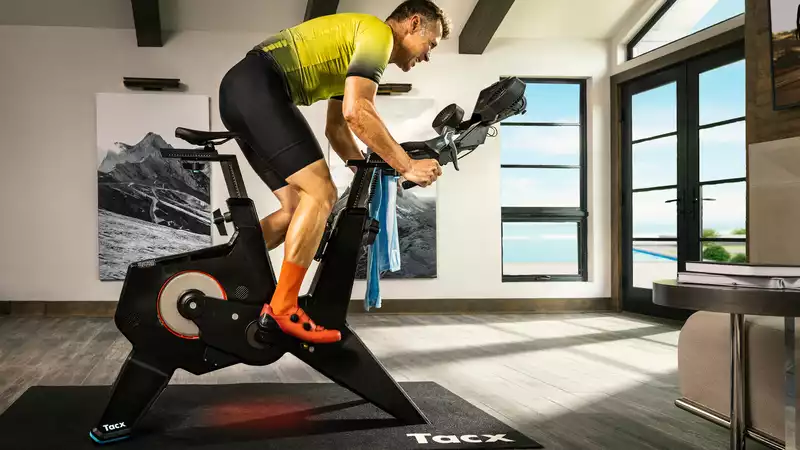Today, Garmin-Tacx announced an update to its Tacx Neo Bike Plus smart bike.
A few years ago, you would have spent your time with your old bike on a turbo trainer or roller, staring at a timer to keep track of your intervals, or watching Paris-Roubaix reruns on a DVD you found in the back of a video store. These days, an old bike on a turbo trainer often encapsulates the indoor riding experience, but now the turbo trainer is a smart, immersive, virtual world to ride in. There are even people in the world to ride with. The entire cycling ecosystem has changed, but it continues to grow and change every year.
The natural next step is to stop using old bikes and instead optimize indoor bikes for indoor riding. Broadly speaking, exercise bikes are called exercise bikes, but there are actually several different types of products available. For more details and options, see our list of Best Exercise Bikes, but within that list is a small list of options that allow you to enjoy your outdoor riding indoors.
These are better known as "smart bikes," which replicate the experience of riding a bike outdoors, but optimize the hardware for the rigors of riding indoors. This is a small category, with the new Tacx Neo Bike Plus being the latest option.
What sets the Neo Bike Plus and its predecessor, the Neo Bike Smart, apart from competitors like the Wahoo Kickr Bike and Stages SB20 is the lack of a standard flywheel. Instead, it has a virtual flywheel that uses magnets and a motor to create the same effect, allowing for several unique features. This is unchanged from the current model, but is an important difference from competing models.
The motor-driven flywheel allows the Tacx to actively speed up the flywheel to better mimic a downhill.
As before, it can simulate a maximum resistance of 2200 watts and a maximum gradient of 25%, but it also has a ride feel feature. The unique flywheel design not only provides resistance, but also allows Tacx to stutter the motor by utilizing the ability to turn the resistance on and off instantly. When done properly, it can simulate a variety of road surfaces, including dirt and gravel roads. These features are also available on the Tacx Neo 2T Smart Trainer and the previous version of the Tacx Neo Smart Bike, and this trend continues with the Garmin Tacx Neo Smart Bike Plus.
Garmin is also an expert in measuring power on the bike. The Garmin Tacx Neo Smart Bike Plus can measure power, speed, and cadence to within 1% accuracy. The dual power meter also allows for deep analysis of pedal strokes. Tracking the position of each leg helps break down pedaling technique and develop a more effective stroke. This is also unchanged from the previous generation.
In terms of hardware, the NeoBike Plus also follows the cockpit configuration, with a pair of fans on either side of a central tablet holder above a small built-in display.
Where small changes can actually be seen is in the physical design of the bike. As noted above, the smart bike eliminates the need for a standard bicycle.
The front of the Tacx Neo Bike Plus has an integrated display, fan, and tablet holder. There is also a pair of shifters that mirror the design of outdoor bicycles. Part of the indoor bike's appeal is that the gearing is purely virtual, mimicking Shimano, SRAM, and Campagnolo, and can be set to a choice of gear ratios. From the included app, you can specify up to three front chainrings with 22-53 teeth per chainring. In the rear, up to 12 sprockets can be mounted on a virtual cassette, with 11 to 40 teeth on each sprocket. When these virtual gears are changed, the same mechanism used for road feel mimics the clunky feel of jumping to a different gear.
Not only are all gearing and controls virtual, but the actual design of the levers and buttons need not be the same as on an outdoor bike. While previous Tacx smart bikes had a more radical shape, this Tacx is much closer to a traditional outdoor design. Judging from the photos, those familiar with Shimano Di2 should feel right at home. [Similarly, the overall design of the bike does not need to mimic an outdoor machine. Aerodynamics and weight need not be considered, and adjustability can be expected. Smart bikes weighing 50 kg/110 lbs. tend to stay in place and be used by multiple people. Easily adjustable seat positions and handlebar stems have been updated to a measurement scale using millimeters for greater precision. Crank lengths are interchangeable between 165mm, 167.5mm, 170mm, 172.5mm, and 175mm by simply screwing the pedals into different mounting holes.
Like all smart bikes (except those made by Peloton), the Garmin Tacx Neo Bike Plus is compatible with your preferred software platform. With standard Bluetooth Smart and ANT+ connectivity, it can be used with TrainerRoad, Zwift, Wahoo SYSTM apps, etc. Tacx also continues to develop its own training apps and currently offers more than 250 real-world videos that simulate riding famous courses around the world. Tacx also continues to develop its own training app, which now includes over 250 real-life videos, structured training plans, and live races that simulate running on the world's most famous courses.
If you don't want to connect to software, you still have several options. Many good cycle computers have ways to control smart bikes, and Garmin's head unit can even follow outdoor routes. In stand-alone mode, no mains power is required, and the Neo Bike Plus simulates flat roads, with more resistance the faster you ride. [MSRP for the Tacx Neo Bike Plus is £3,499.99/$3,999.99. For more information on the Tacx Neo Bike Plus, visit Garmin's website.
.

Comments